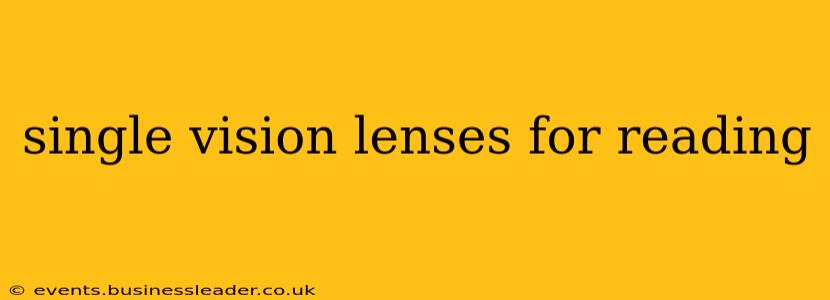Reading glasses are a ubiquitous part of life for many, marking a transition into a new stage of vision. Understanding the nuances of single vision lenses, specifically for reading, can empower you to make informed choices about your eye health and visual comfort. This guide delves into the specifics of single vision reading lenses, addressing common questions and concerns.
What are single vision lenses?
Single vision lenses, as the name suggests, provide a single power correction across the entire lens. Unlike progressive lenses (also known as multifocal lenses), which offer a gradual change in power for different distances, single vision lenses offer a consistent correction, ideal for a specific distance, such as reading. This means they're perfect for those whose vision correction needs are focused primarily on near vision.
What is the difference between single vision and bifocal lenses?
While both single vision and bifocal lenses address vision correction, they do so differently. Single vision lenses provide one power for a single distance, typically near vision for reading glasses. Bifocal lenses, on the other hand, have two distinct areas of correction: one for distance vision and one for near vision, often separated by a visible line. The choice depends on individual needs. If you primarily need correction for near vision, single vision lenses are a simpler and often more cost-effective solution. Bifocals are better suited to individuals who need correction for both near and far vision.
How do I choose the right strength for reading glasses?
Determining the correct strength for your reading glasses is crucial for comfort and avoiding eye strain. It's strongly recommended to have your eyes examined by an optometrist or ophthalmologist. They can accurately measure your refractive error and prescribe the appropriate lens power. Self-prescribing can lead to eyestrain, headaches, and potentially harm your vision.
Are single vision reading glasses better than bifocals or progressives?
The "best" type of lens depends entirely on individual needs and visual habits. Single vision reading lenses are excellent for those who primarily need near vision correction and don't require distance correction. Bifocals are suitable for those who need both near and far vision correction. Progressive lenses offer a seamless transition between different distances, but they can have a longer adjustment period. An eye care professional can help determine the best option for your specific vision needs.
What are the benefits of single vision reading glasses?
Single vision reading glasses offer several advantages:
- Simplicity: They provide clear, sharp vision at the reading distance, without the complexities of bifocals or progressive lenses.
- Cost-effectiveness: They are generally less expensive than bifocals or progressive lenses.
- Ease of adjustment: There is no adjustment period needed, unlike progressive lenses.
- Clear vision: The single power focus provides crisp, uninterrupted vision at the designated distance.
How long do single vision reading glasses last?
The lifespan of single vision reading glasses depends on several factors, including the quality of the lenses and the frequency of use. Generally, with proper care, they can last for several years. However, regular eye exams are crucial to ensure your prescription remains accurate and your glasses continue to provide optimal visual comfort. Changes in vision may necessitate a new prescription and pair of glasses.
Can I buy single vision reading glasses online?
While you can purchase reading glasses online, it's crucial to remember that an accurate prescription is essential for clear vision and eye health. Buying glasses online without a proper eye examination is risky and could potentially damage your vision. Online retailers offering reading glasses typically only provide a limited range of powers, making it difficult to find the perfect fit without professional guidance. While convenient, online purchases should only be considered if you already have a valid prescription.
What are the different materials available for single vision reading lenses?
Single vision reading lenses are available in various materials, each with its advantages and disadvantages:
- CR-39: A common and relatively inexpensive plastic lens material, offering good clarity and impact resistance.
- Polycarbonate: A highly impact-resistant material, often preferred for children or those involved in activities with a higher risk of eye injury.
- High-index plastics: Thinner and lighter than CR-39, particularly beneficial for stronger prescriptions.
Your optometrist can help you choose the most suitable material based on your individual needs and prescription.
This comprehensive guide offers a detailed overview of single vision lenses for reading. Remember, consulting with an eye care professional is crucial for accurate prescription and proper fitting to ensure optimal vision and eye health.
